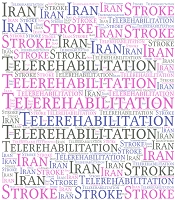Stroke is a leading cause of disability in adults worldwide. In 2021, the prevalence of stroke was 93.8 million (1). Stroke ranked first among the top ten conditions with the highest age-standardised disability-adjusted life-years (DALYs) in 2021 (2). In Iran, the socioeconomic burden of stroke is growing alarmingly due to rising costs and limited neurorehabilitation infrastructure. Traditional stroke rehabilitation requires regular, in-person physiotherapy sessions, which many Iranian families cannot afford due to inflation, transportation challenges, regional disparities in care access, and the war. Consequently, effective, accessible, and affordable strategies to enhance stroke recovery must be urgently implemented to reduce its burden (1). In this context, telerehabilitation via mobile devices emerges not only as an innovative solution but also as a necessity.
Telerehabilitation uses telecommunication devices to provide evaluation and rehabilitation interventions remotely (3). Studies now support the efficacy of telerehabilitation for stroke survivors (4). A recent systematic review and meta-analysis concluded that telerehabilitation is as effective as conventional therapy in improving motor function and activities of daily living in post-stroke patients (5). One telecommunication device is the mobile phone. Through mobile video calls and applications, patients can receive real-time professional guidance from physiotherapists while remaining in their homes. This therapy model minimizes costs, improves access, and maintains continuity of care to enhance stroke recovery. Mobile-based telerehabilitation can also increase adherence and motivation.
The number of smartphone users in Iran has been steadily increasing for 15 consecutive years. From 2024 to 2029, the user base is expected to grow by 12.2 million, a 16.1% increase, reaching 87.91 million users by 2029 (6). With the digital economy recognized as a national priority, this growing smartphone infrastructure could help address the care gap for Iranian stroke survivors. Mobile-based telerehabilitation programs, designed with culturally relevant content and user-friendly interfaces, can improve acceptance and usability among Persian-speaking patients with stroke.
Despite its promise, telerehabilitation in Iran faces barriers such as limited digital literacy among older adults, inconsistent internet coverage, slow internet speed, and the absence of national guidelines. To address these challenges, policymakers must invest in digital training for both patients and therapists, expand internet accessibility, and integrate telerehabilitation services into the national health insurance system.
Implementing digital, mobile-based rehabilitation services can reduce hospital readmissions and minimize outpatient travel expenses in the current context in Iran. Importantly, it allows family members to actively participate in the rehabilitation process of their stroke patients. Mobile-based telerehabilitation aligns with cost-containment goals. The integration of mobile-based telerehabilitation into stroke care offers a timely, feasible, and cost-effective solution to bridge the gap and enhance stroke recovery in Iran. Future research should focus on its effectiveness, patient satisfaction, validation of developed mobile applications, assessment of cost-effectiveness, and recovery outcomes.
